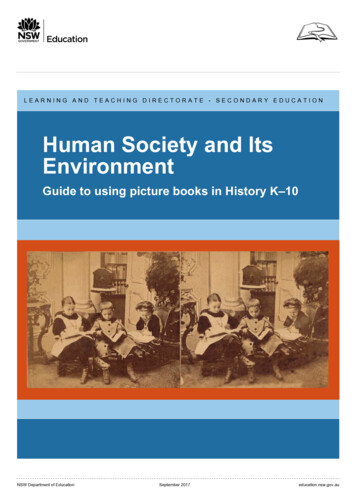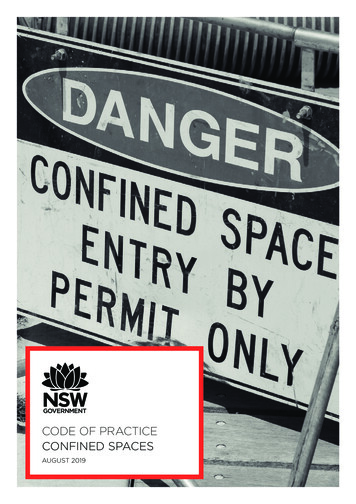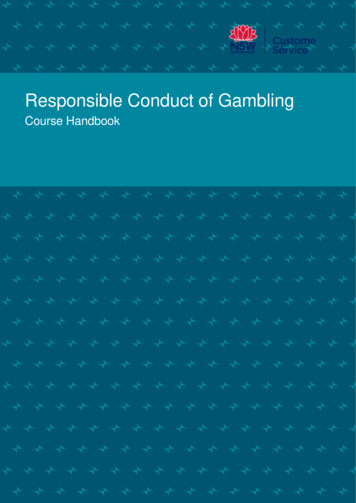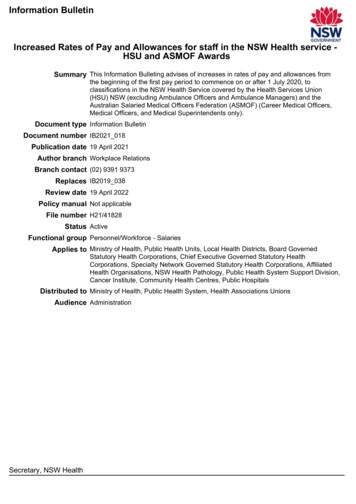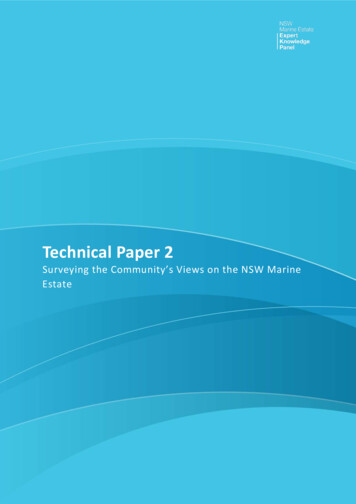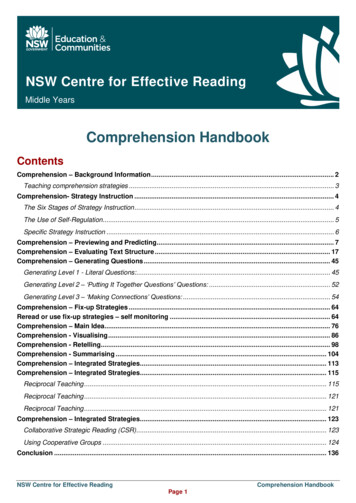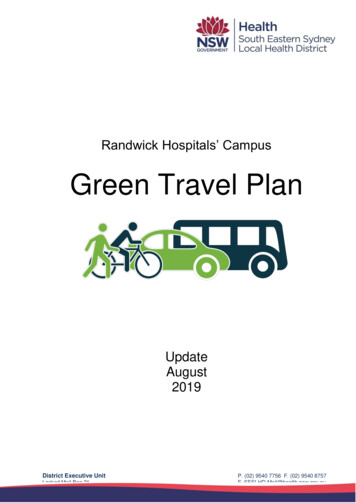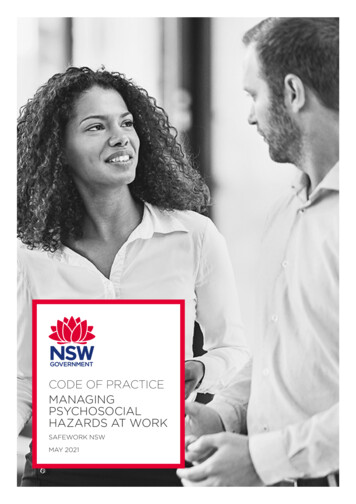
Transcription
CODE OF PRACTICEMANAGINGPSYCHOSOCIALHAZARDS AT WORKSAFEWORK NSWMAY 2021
This Code of Practice has been developed by SafeWork NSW and has been approved under section274 of the NSW Work Health and Safety Act 2011. The code commenced on the date of gazettal on28th May 2021.ISBN 978-0-642-33297-4 [PDF]ISBN 978-0-642-33298-1 [RTF]Copyright Information State of New South Wales You may copy, distribute, display, download and otherwise freely dealwith this publication for any purpose provided that you attribute the Department of Customer Serviceas the owner. This publication is licensed under the Creative Commons Attribution 4.0 licence.For more information, visit www.nsw.gov.au/copyright.
CONTENTSForeword 4Scope and application 4How to use this Code of Practice andkey terms 41.Introduction 1.11.22.16What are the common psychosocialhazards at work? 6Individual factors 92. Who has duties to manage psychosocialhazards at work? 10Persons conducting a business orundertaking 10Primary duty of care 3.4Step Three: Control psychosocialhazards and risks Eliminate or minimise risk through goodwork design 21Safe systems of work Reasonable adjustments for individualworkers 22Controlling residual risks 22Implementing controls 233.510Step Four: Proactively implement,maintain, monitor and review theeffectiveness of controls 11Multiple duty holders 11Duties cannot be transferred 124.12.2An Officer of a PCBU 13Notifiable incident 2.3Workers of the PCBU 144.22.4Other persons at the workplace 143.115Essential elements of an effectivesystematic risk management process 15Leadership and management commitment 15Keeping a record of the riskmanagement process and outcomes 255. Supporting a safe return to work after awork-related harm 26Appendices 27Appendix A. Example scenarios for managingpsychosocial hazards and risks at work 28Scenario 3. Government call centre 30Scenario 4. Construction company 31Scenario 5. Small consulting firm 32Scenario 6. Retail store 33Scenario 7. Private health care provider 34Scenario 8. Manufacturing business 35Scenario 9. Very small trucking company 3620Scenario 10. Mining workplace 3720Appendix B. Example of a Risk Register 38Adequate planning 1616Systematically collecting and reviewingavailable information and data 17Observe and talk to workers about workactivities 18Determine the psychosocial risk 252916Step Two: Assess and prioritise thepsychosocial hazards and risks Investigating a psychosocial incident 24Scenario 2. School Consulting those in your supply chains 3.34. Responding to a report of a psychosocialrisk or incident 242815Step One: Identify the psychosocialhazards 23Scenario 1. Health Care Consulting workers 3.221Information, training, instruction orsupervision 22Duty to consult workers 3. What is involved in managingpsychosocial hazards at work? 21
FOREWORDThis code of practice on how to managepsychosocial hazards at work is an approvedcode of practice under section 274 of the NewSouth Wales Work Health and Safety Act 2011(WHS Act).An approved code of practice provides practicalguidance on how to achieve compliance with thework health and safety standards required underthe WHS Act and the Work Health and SafetyRegulation (WHS Regulation), including effectiveways to identify and manage risks.A code of practice applies to anyone who has aduty of care in the circumstances described inthe code of practice. In most cases, following anapproved code of practice will assist the dutyholder in achieving compliance with the healthand safety duties in the WHS Act and WHSRegulation concerning the code’s subject matter.Like regulations, codes of practice tend to dealwith particular risks, and do not cover all hazardsor risks that may arise. The health and safetyduties require duty holders to consider all risksassociated with work, not only those for whichregulations and codes of practice exist.Codes of practice are admissible in courtproceedings under the WHS Act and the WHSRegulation. Courts may regard a code of practiceas evidence of what is known about a hazard,risk or control and may rely on the code indetermining what is reasonably practicable inthe circumstances to which the code relates. Forfurther information, see Safe Work Australia Howto determine what is reasonably practicable tomeet a Health and Safety Duty.Compliance with the WHS Act and WHSRegulation may be achieved by following anothermethod if this achieves an equivalent or higherstandard of safety than set out in this code.An inspector may refer to an approved codeof practice when issuing an improvement orprohibition notice.4SAFEWORK NSWSCOPE AND APPLICATIONThis code is intended to be read by personsconducting a business or undertaking (PCBU)and those who have duties under the WHS Act.It provides practical guidance on the processa PCBU could use to identify and to managepsychosocial hazards at work. You should usethis code of practice if you have functions orresponsibilities that involve managing, so far as isreasonably practicable, exposure to psychosocialhazards and risks to psychological and physicalhealth and safety at work.The code may also be a useful reference forother persons interested in complying with theduties under the WHS Act and WHS Regulation.Examples in this code identify actions a PCBU,an officer of a PCBU, a worker, or other personsshould take, but which by themselves may notbe sufficient to fulfil a PCBU’s obligations or aworker’s or other person’s responsibility underWHS legislation.This code applies to all work and workplacescovered by the WHS Act. Throughout this code,the reasonably practicable limitation undersection 18 of the WHS Act applies to the generalduty.HOW TO USE THIS CODE OFPRACTICE AND KEY TERMSThis code includes references to requirementsunder the WHS Act and WHS Regulation. Theseare included for convenience only and should notbe relied on in place of the full text of the WHSAct or WHS Regulation. Codes of practice do notcreate new WHS duties, nor do they extend anyexisting duties, but rather explain how to meetthose duties.The words ‘must’ or ‘require’ indicates thata legal requirement exists and must be met,‘should’ indicates a recommended course ofaction, and ‘may’ an optional course of action.This code’s advice covers the prevention ofexposure to psychosocial hazards at work, whichmay create psychological or physical health andsafety risks.
A duty holder means any person who owesa duty under the WHS Act, including a PCBUwith management and control of a business,or a designer, manufacturer, importer, supplier,installer of products or plant used at work(upstream duty holder), or officer or a worker.A worker means any person who carries outwork for a PCBU, including work as an employee,contractor or subcontractor (or their employee),self-employed person, outworker, apprentice ortrainee, work experience student, an employeeof a labour-hire company placed with a ‘hostPCBU’, or a volunteer. Managers and supervisorsare also workers.A PCBU also owes a duty of care to personsother than their workers whose health or safetymay be put at risk – that is, to any person whomay be affected by the business operations suchas visitors, customers or members of the public.A workplace means any place where work iscarried out for a business or undertaking, or wherea worker goes, or is likely to be, while at work.Work health and safety (WHS) hazards areanything that can cause harm. Risk means thepossibility of harm (death, injury or illness) whichmight occur if a worker is exposed to a hazard.Control measures (controls) are actions taken toeliminate or minimise WHS hazards and risks.CODE OF PRACTICE – MANAGING PSYCHOSOCIAL HAZARDS AT WORK5
1. INTRODUCTIONThe WHS Act defines ‘health’ as including bothphysical and psychological health. A PCBU hasa primary duty to ensure, so far as is reasonablypracticable, the health and safety of workersand also to ensure that other persons are notput at risk from work carried out arising from thebusiness or undertaking.When psychosocial hazards and risks at workare not effectively managed, this may increasethe risk of work-related psychological andphysical injuries, incidents and errors. Therefore,it may be helpful when assessing the risk ofmusculoskeletal and traumatic injury to considerthe psychosocial hazards and risks and controlsnoted in the code.Ensuring a systematic process to managepsychosocial hazards and risks will helpthe PCBU and duty holder meet theirWHS responsibilities. It will also decreaseorganisational disruptions and costs resultingfrom work-related harm and may improve WHSand broader organisational performance andproductivity.1.1WHAT ARE THE COMMONPSYCHOSOCIAL HAZARDSAT WORK?Psychosocial hazards at work are aspects ofwork and situations that may cause a stressresponse which in turn can lead to psychologicalor physical harm. These stem from: the way the tasks or job are designed,organised, managed and supervised tasks or jobs where there are inherentpsychosocial hazards and risks the equipment, working environment orrequirements to undertake duties in physicallyhazardous environments, and social factors at work, workplace relationshipsand social interactions.Psychosocial hazards and the appropriatecontrols will vary for every workplace andsometimes between groups of workersdepending on the:6SAFEWORK NSW organisational context to work (e.g. economicpressures, type and size of the business,organisational structure and culture,environmental conditions, technologies, andbusiness activities, products and services,supply chains and contractual arrangements,workers’ skills and attributes and workplacerelationships) and content of the work (workload, workers’ roles,responsibilities and activities required todeliver the product or service).Some hazards by themselves have the potentialto cause serious harm, such as experiencingoccupational violence. In most circumstances,hazards will not occur alone but togetherwith a range of psychosocial and physicalhazards. As part of the risk assessment processthe frequency and duration of exposure topsychosocial hazards will need to be considered.The more psychosocial hazards that are present,the more likely there is for harm to occur.Some of the most common psychosocial hazardsare noted in Table 1. There may be hazards notrelevant to your work or relevant to your workbut not included. These will be identified throughyour hazard and risk identification process.
Table 1 Common psychosocial hazardsHazardExampleRole overload (highworkloads or jobdemands)For example, where there is: too much to do in a set time or with insufficient workers or other resources unachievable task deadlines, expectations or responsibilities unpredictable shifts or hours of work, shift structures or rosters that do notallow adequate time for workers to recover frequent cognitively difficult work multiple tasks that require repeated rapid switching between each to completethem, so it is difficult to concentrate where there is sustained or frequent exposure to emotionally distressingsituations tasks that require workers to continually show false displays of emotion, e.g.customer service roles tasks and decisions that are safety critical and that may have a serious impacton the health and safety of workers and others.Role underload (lowworkloads or jobdemands)Where there is sustained low effort required, for example: tasks or jobs where there is routinely too little to do highly repetitive or monotonous work (like picking and packing products,monitoring production lines).Exposure totraumatic eventsWhere workers provide care to those experiencing a traumatic event or listen to,view, or read detailed descriptions of harrowing and traumatic events experiencedby others. For example: emergency responders or health care workers rape crisis and child protection workers, officers of the court, lawyers orimmigration officers etc experiencing, witnessing, or investigating a serious near miss, injury orworkplace fatality.Role conflict or lackof role clarityFor example, where there are: conflicting priorities within roles (e.g. providing ‘good customer service’, butwith insufficient time allowed to spend with customers) uncertainty around roles, tenure, tasks and work schedules and standards(frequent changes, lack of clear explanations to role or tasks, importanttask-related information/training is not available, or not providing a clearperformance agreement or reporting requirements).Low job controlFor example, where workers: have little control over how they do their work, when they can change tasks ortake breaks are not involved in decisions that affect their work or clients are unable to speak up about WHS, and the way work is done.Note: Where the safety or quality requirements need to be strictly prescribed,there is likely to be more limited opportunities for worker input into decisionmaking, however workers must still be consulted.Conflict orpoor workplacerelationshipsbetween workersand their supervisorsand managers andco-workersFor example, where there are: frequent disagreements about how work should be done frequent interpersonal workplace conflict harmful workplace behaviours.Conflict can be stressful, especially where the consequences of miscommunicationcan lead to additional time pressures or serious errors. Conflict can escalate if itis not dealt with promptly and fairly and if steps are not taken to address poor,unacceptable or harmful behaviours.CODE OF PRACTICE – MANAGING PSYCHOSOCIAL HAZARDS AT WORK7
8HazardExamplePoor support fromsupervisors andmanagersFor example, where there is: inadequate information, advice and help with work tasks or to resolve issues, oraccess to necessary equipment and resources performance feedback or other management action which is unreasonableor delivered in an unreasonable manner. See also clarification on reasonablemanagement action on page 9.Poor co-workersupportFor example, where there is: inadequate information, advice and help to complete tasks, and support forwork-related matters from co-workers.Workplace violenceIncluding, by workers, clients, patients, visitors or others. For example, seeSafe Work Australia Guide: Preventing workplace violence and aggression; andWorkplace violence and aggression – guidance for small business, and Workplaceviolence and aggression – advice for workers.BullyingIncidents of bullying by workers, clients, patients, visitors or others. For example,see SafeWork Australia: Guide for preventing and responding to workplace bullying,and Dealing with workplace bullying - a worker’s guide.Harassmentincluding sexualharassmentSingle or repeated incidents of forms of harassment by co-workers, clients,patients, visitors or others around a person’s race, religion, gender, age, disabilityetc. For example see information from Safe Work Australia: Guide: Preventingworkplace sexual harassment and Preventing workplace sexual harassment guidance for small business and Workplace sexual harassment – advice for workers.Inadequate rewardand recognitionFor example, where: workers’ efforts are not recognised there aren’t reasonable opportunities for skills development and fair careeradvancement.Hazardousphysical workingenvironmentsWhere there is exposure to hazardous physical working environments to the extentthat it evokes a physiological or stress response. For example, due to concernsabout exposure to biological or chemical agents where there is inadequatepersonal protective equipment (PPE).Remote or isolatedworkArising from the location, time or the nature of the job. For example: where there is limited access to other people, reliable communication ortechnology to get physical and emotional support, if required working alone or in other peoples’ homes if accessing help, especially in anemergency, is difficult (such as, where there is potential exposure to violent oraggressive behaviour).Poor proceduraljustice (processesfor makingdecisions)Where there are absent or inadequate, unfair or inconsistent application of theprocesses, for example: applying organisational policies or procedures (for example, fair access topreferred shifts or overtime) allocating work and resources, or managing job performance.Poor organisationalchange consultationFor example, where there is: poor consultation or communication with other relevant duty holders or affectedworkers about significant changes insufficient consideration of the impact of changes on WHS and performance poor practical support for affected workers during change implementation.SAFEWORK NSW
If inappropriate or harmful workplace relationshipsand behaviours are identified, the PCBU shouldrecord these as psychosocial hazards andinvestigate work-related contributing causes. Insome circumstances, poor workplace behavioursmay be an inappropriate response to high jobdemands or inadequate support (e.g. excessivetime pressures, lack of role clarity or inadequatetraining and skills). To effectively control risks,duty holders will need to eliminate or minimise theunderlying causes as well as directly addressingunacceptable or harmful behaviours.REASONABLE MANAGEMENT ACTIONManaging psychosocial hazards and risksmay require decisions that may be perceivedas causing stress and therefore a WHSrisk. However, reasonable managementaction, when carried out lawfully and in areasonable way, may be uncomfortable ordistressing to some, but is a legitimate wayfor managers and supervisors to:– lead, direct and control how work isdone– give feedback and manageperformance, including aroundinappropriate or harmful workplacebehaviours– deal with differences of opinion anddisagreements, or/and– recruit, assign, transfer, implementdisciplinary action or terminateemployment.For more information refer to Fair WorkCommission guidance material What does‘reasonable management action carried outin a reasonable manner’ mean?1.2 INDIVIDUAL FACTORSWhile the psychosocial hazards outlined aboveinfluence the likelihood and severity of harm,there may be individual differences in howpeople perceive and respond to the samepsychosocial hazards, just as there are withphysical hazards.When managing psychosocial hazards, the PCBUshould take into account tasks and activitiesthat may increase risks to particular groups, forexample, workers: who are younger, in training, older, or who arenew to the organisation or doing those tasks with diverse language, literacy, numeracy, orcultural backgrounds, or who have experienced work-related injury,illness or previous exposure to a traumaticevent.The PCBU’s risk management process should: identify reasonably foreseeable risks for theseworkers ensure risk controls take these workers’ needsinto account, and ensure a fair and transparent process, soworkplace behavioural standards are knownand upheld, including reminding all workersof their legal duty not to cause harm throughtheir behaviours to others or themselves whileat work.By talking to your workers, including those fromat-risk groups, you can decide if they may needadditional support to be healthy and safe atwork.Where non-work-related factors, for example,a worker’s personal circumstances or mentalor physical health status may increase their riskof harm at work, the PCBU is required to makereasonable adjustments under the DisabilityDiscrimination Act 1992.CODE OF PRACTICE – MANAGING PSYCHOSOCIAL HAZARDS AT WORK9
2. WHO HAS DUTIES TO MANAGEPSYCHOSOCIAL HAZARDS AT WORK?Everyone involved in the workplace has healthand safety duties when carrying out the work;this includes PCBUs and other duty holders.Examples of what the PCBU is required to do tomanage psychosocial hazards include ensuringthe provision and maintenance of: safe systems of work2.1 PERSONS CONDUCTINGA BUSINESS ORUNDERTAKING a safe working environmentPrimary duty of care necessary information, training, instruction orsupervision of workers, andWHS Act 2011 s19(1) Primary duty of care toworkersWHS Act 2011 s19(2) Primary duty of careto othersA PCBU has the primary duty to ensure, so far asis reasonably practicable, the health (includingpsychological health) and safety of eachworker who is engaged, caused to be engaged,influenced or directed by the PCBU while theworker is at work in the business or undertaking.This means that the PCBU must ensure thatpsychosocial hazards at work are effectivelymanaged by first trying to eliminate psychosocialhazards, and only if that is not reasonablypracticable, then by minimising the remainingrisks so far as is reasonably practicable. ThePCBU’s duty to workers includes ensuring thehealth and safety of workers from harmful actsfrom third parties, such as clients, patientsor their families, and students in educationalinstitutions.The PCBU must also ensure, so far as is reasonablypracticable, that the health and safety of anyperson who is not one of the PCBU’s workers isnot put at risk from work carried out as part of theconduct of the business or undertaking.WHS Act 2011 s19(3) What is required to fulfilthe primary duty of care10SAFEWORK NSW the safe use, handling, and storage of plant,structures and substances adequate access to welfare facilities at work the health of workers and the conditions atthe workplace are monitored to ensure anyrisks remain adequately controlled.OUTSOURCING, CONTRACTING,PARTNER AND PROCUREMENTARRANGEMENTSOutsourcing, contracting, partner andprocurement arrangements will affect howwork is done and may create psychosocialhazards for workers in organisations involvedin this supply chain and others such ascontractors or suppliers. The PCBUs mustensure, so far as is reasonably practicable,that their own workers and others health andsafety, such as suppliers and contractors arenot put at risk by the arrangements.Duty holders affected by the outsourcing,contracting and procurement must beconsulted on clear arrangements made onhow the shared duty to protect and promotethe health, safety and well-being of workerswill be managed by each duty holder.WHS Act 2011 s17 Management of risksWHS Act 2011 s18 Reasonably Practicable
The PCBU’s duty in section 17 of the WHS Actis to take measures to eliminate the risk; and ifthis is not ‘reasonably practicable’, to minimisethe risks ‘so far as is reasonably practicable’. Inworking out what is ‘reasonably practicable’, thePCBU must take into account and weigh up allrelevant matters, including the likelihood of the psychosocial hazard orrisk occurring the degree of harm that might result from thehazard or risk the availability and suitability of ways toeliminate the hazard or risk what the PCBU knows or ought reasonablyto know about the hazard or risk and ways ofeliminating or minimising the risk.Once these factors have been weighed up, thePCBU may consider the cost of the measuresto eliminate (or minimise) the risk – but ameasure is only considered not reasonablypracticable if the cost of implementing it isgrossly disproportionate to the risk e.g. the costof engineering changes to plant will be high andthere is only a slight risk of minor sprains.Duty to consult workersWHS Act 2011 s47 Duty to consult workersWHS Act 2011 Part 5 Consultation,representation and participationAll PCBUs have a duty to consult, as far as isreasonably practicable, with all workers whocarry out work for the business or undertakingand who are likely to be directly affectedby a health and safety matter. In particular,consultation is required when the PCBU isconducting risk management activities asrequired by its section 19 duty, and when itproposes any changes that might affect thehealth and safety of workers. PCBUs’ otherobligations include negotiating with workers toestablish work groups; facilitating the electionof health and safety representatives (HSRs) forthose work groups; allowing choice of course andpaying for HSRs to attend an approved course(s)of WHS training; conferring and consultingwith HSRs; and providing them with reasonablynecessary resources, facilities and assistance.WHS Act 2011 s68 Powers and functions ofhealth and safety representativesA HSR should: undertake training on psychosocial hazardsand risks, their duties and risk management,and talk to workers they are representing aboutany psychosocial hazards and work-relatedrisks and monitor actions taken to addressconcerns, and raise concerns about psychosocial hazardsand risks in relevant meetings with the PCBUand provide feedback to the affected workerswhilst protecting privacy and confidentialitywhere required.Multiple duty holdersThe nature of the work being undertaken maymean that more than one PCBU may haveduties to manage the psychosocial hazards. Forexample, PCBUs: who are carrying out work on the same site(e.g. where work schedules and deliveriesneed to be coordinated so as not to createunreasonable time pressures or ensure safe siteaccess, or where visiting care workers need toknow if a client’s behaviour may be a risk) who together deliver a service (e.g.government agencies who establish thesystems and policies that affect the workactivities of others), or have management or control of a workplacewhere other PCBUs and their workers areworking.WHS Act 2011 s46 Duty to consult with otherduty holdersAll persons with a duty under the WHS Act mustconsult, cooperate and coordinate with otherpersons who owe a duty in relation to the samematter. For example, in managing psychosocialhazards and risks a PCBU will need to consult,cooperate and coordinate activities with partnerorganisations, suppliers, sub-contractors,building managers or workers.CODE OF PRACTICE – MANAGING PSYCHOSOCIAL HAZARDS AT WORK11
Duties cannot be transferredWHS Act 2011 s14 Duties not transferableWHS Act 2011 s272 No contracting outA PCBU cannot transfer or delegate any of itsduties to another person. Nor can the PCBUcontract out their health and safety duties, butthey can consult, cooperate and coordinate withother PCBUs to do the things that will assistthem in meeting their duties.WHS Act 2011 s16 Each duty holder must complyWhere two or more PCBUs have the sameduty, each must comply with that duty, even ifanother duty holder has the same duty. Theirrequirement to discharge this duty is, however,limited by the extent to which they can influenceand control the matter.Consulting, cooperating and coordinatingactivities with other duty holders in yourcontractual networks, including supply chains,will help address WHS risks that often occurwhen: there is a lack of understanding of how theactivities of each person may create risks forothers duty holders assume someone else is takingcare of the health and safety matter the person who takes action is not the bestperson to do so.When duty holders within a supply chain actcooperatively, they can implement more effectivecontrols than when acting alone.WHS Act 2011 s15 A person can hold more thanone dutyA PCBU can also have multiple duties, forexample, if they carry out work for anotherPCBU as a subcontractor, as a PCBU they holdthe primary duty of care, the duty to consultworkers, and the duty to consult, cooperate andcoordinate, and they must also comply with theduties of a worker noted below.12SAFEWORK NSWEXAMPLES OF HOW TO DO THIS:A PCBU should ensure that their approachto systematic work health and safetymanagement is effective by:– identifying psychosocial hazards presentin their workplace—for example throughworker consultation and consideringorganisational experience, data andsurveys– eliminating psychosocial hazardsor minimising psychosocial risk byredesigning the work with saferalternatives– providing safe systems of work bymanaging how, where and when workis done, as well as who is involved inperforming the work, so the tasks andwork are safe– providing relevant information, training,instruction and/or supervision forworkers on how to do the work safelyand well, appropriate to their rolesand responsibilities in the workplace(including to those responsible formanaging or supervising the work ofothers)– ensuring where required, actions areimplemented early, and monitoringoccurs of the work environment,processes and workers’ health to preventthe onset of work-related psychologicalor physical injury or illness.The PCBU’s goal to produce a product orprovide, for example, a particular model ofpatient care, achieve particular educationaloutcomes for students, or a focus oncustomer service, cannot override the dutythat the WHS Act 2011 places on the PCBUto ensure, so far as is reasonably practicable,the WHS of their workers and others.
2.2 AN OFFICER OF A PCBUWHS Act 2011 s27 Duty of officersOfficers, such as company directors, seniormanagers and executives of governmentagencies, have an immediate, positive andproactive duty to exercise due diligence toensure the PCBU complies with the WHS Act andWHS Regulation.Each officer of the PCBU must separately takereasonable steps to meet their due diligenceobligations concerning psychosocial hazards tohealth and safety. This means an officer must,for example: understand their WHS legal duties understand the nature of the PCBU’soperations and the hazards and risksassociated with those operations have a method to stay up to date on WHSmatters of their organisation includingpsychosocial hazards ensure the PCBU is allocating the financialand human resources and is developing thesystematic health and safety managementprocesses required to eliminate or minimisepsychosocial risk so far as is reasonablypracticable; and take active measures to ensure that the aboveprocesses have occurred and are effective.This duty requires officers to actively seek outrelevant knowledge and understanding to makea decision or take action. In some circumstances,that may mean they need to rely on others’information. Where this is the case, they shouldverify the credibility and appropriateness of thesources of information.EXAMPLES OF HOW TO DO THIS:An Officer– understands what their
A code of practice applies to anyone who has a . duty of care in the circumstances described in . the code of practice. In most cases, following an approved code of practice will assist the duty holder in achieving compliance with the health and safety duties in the . WHS Act. and . WHS Regulation . concerning the code's subject matter.

